
Modern laptop designs place great value on aesthetic appearance. Looking through an electronics showroom reveals a wide variety of sleek, cool-looking machines in dark colors, with textured lids and matte finishes. Unfortunately, many laptop casings are built from plastic, and the portability of laptops exposes them to wear and tear that can leave unsightly scratches; this is frustrating, particularly if you bought a premium laptop you want to show off.
You can remove scratches from a laptop lid in several ways, depending on the depth of the scratch and your laptop's material. In general, however, these solutions don't work on the anodized aluminum casings MacBooks are known for. Tending to the soft-finished metal requires an approach that differs from removing scratches on plastic and carbon fiber.
Video of the Day
Video of the Day
Removing Scratches With Plastic Polish
If you search stores for a dedicated laptop scratch remover, you will likely come up short. However, most laptop lids with scratches can be restored with a commercial plastic polish. Clean the laptop lid well with a solution of water and dish soap and dry it with a lint-free towel. Pour a small amount of the polish onto a cloth and slowly work it into the lid. Rub in a circular motion, applying more polish as necessary until you've worked your way across the entire laptop lid. Wipe in an up and down motion until the lid has absorbed the polish and then wipe the lid with a clean cloth.
The scratch or scratches should now be gone. If they aren't, repeat the process until the marks disappear. This process works best on standard plastic laptop lids. Laptop lids made with a hybrid of plastic and carbon fiber can still be polished, but reflective hybrid lids with scratches should be treated more carefully. It may be beneficial to use a paint pen meant for automotive cosmetic treatment, such as those made by Quixx, to treat the problem.
DIY Computer Scratch Remover
If you can't find plastic polish or a paint repair pen, you may be able to remove laptop lid scratches by making a homemade computer scratch remover. These solutions work best on standard plastic laptop lids but can be effective on carbon fiber hybrid lids with texturing. First, clean them as you would when using a commercial polish. Remove light scratches by gently polishing with toothpaste, using circular motions with a cloth.
Tackle heavier scratches with lemon slices and baking soda. Pour baking soda into a bowl and coat the lemon slices with the soda. Rub the slices against the scratches in a back and forth motion, pressing slightly to release some of the lemon juice. Dip the slices into the baking soda regularly during this process and continue to rub until the scratch disappears. When using either of these solutions, be careful not to get the cleaner into any cracks or spaces where it may make contact with internal electronics. Use a damp – not wet – cloth to clean any sticky residue from the laptop lid.
Protecting From Future Scratches
After you remove the scratches from your laptop, you'll want to prevent additional scratches from appearing in the future. You may not want to protect your laptop with a hard case that protects from most types of scratches, knocks, and drops because it harms the aesthetic appeal of the machine. There are other ways to keep your laptop from taking cosmetic damage.
One of the most important measures you can take is to keep your laptop in a soft, secure case or sleeve – and ensure that it isn't stored alongside sharp objects like pens, paperclips or keys. At the same time, when the laptop is out and in use, pay attention to its placement and position the lid where it doesn't rub against walls or other surfaces, as movements that occur as you use the laptop can lead to light or deep scratches.
- BlackBeltReview: How to Fix Scratches on a Laptop Lid
- RichsMethods: How to Remove Scratches From Laptop or Plastic Electronics (Quick Tip)
- DT: Removing Heavy Scratches From a HP Laptop Cover With a Lemon + Baking Soda
- BrightHub: How to Repair Scratches Aluminum MacBook
- Tom's Guide: Gadget Materials Guide: Aluminum vs Carbon Fiber, Plastic and Glass
- LORD Corp: What You Need to Know About Repairing Carbon Fiber